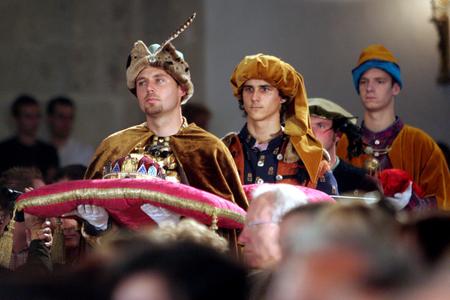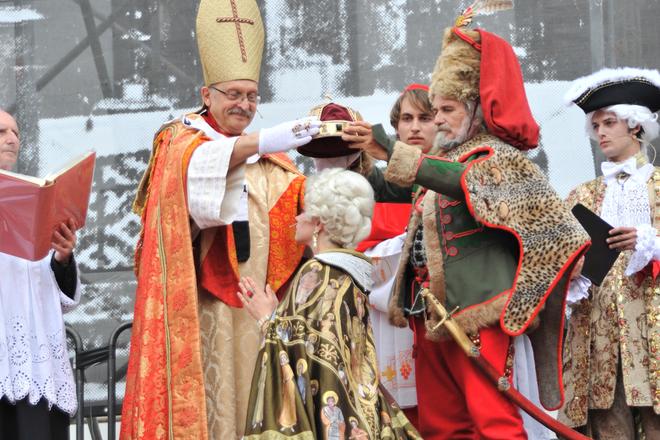Exactly after 275 years Bratislava will again experience the coronation of Maria Theresa. During the final weekend of June residents and visitors to Bratislava will have the opportunity to see the coronation ceremony and enjoy Frankovka red wine flowing from a fountain, taste roasted beef or catch coronation coins. Via the re-enactment of coronation ceremonies and other festivities Bratislava will relive its famous history as a coronation city.
“Our ambition is to make the coronation ceremony as authentic as possible,” Miroslav Vetrík, the organiser and author of the idea of the coronation re-enactment, told The Slovak Spectator, adding that the course of the coronation is quite well known, while period paintings provide additional details.
Coronation ceremonies are back
This year Bratislava will host the re-enactment of the coronation ceremonies for the 14th time, after the first such event in 2003.
“In 2002 when preparing for entry exams for law studies I became astounded by the rich history of Bratislava as the capital of the former country as well as its coronation city,” Vetrík recalled for The Slovak Spectator, adding that at that time the idea to re-enact the coronation ceremony was born.
The first edition featured re-enactment of the coronation of the first king crowned in Bratislava, then called Pressburg, Maximilian II, and it was met with high interest of people and a new tradition began. During the following years re-enactments of kings and queens followed chronologically, but an exception was made in 2011 – the 270th anniversary of the coronation of Maria Theresa.
“Maria Theresa is the most important and popular monarch crowned in Bratislava,” said Vetrík. “She had the greatest merit in the development of Bratislava. Because of this we decided to re-enact her coronation every fifth year. Other coronations will follow the chronological order.”
The first four editions took place at the exact location of the original coronations, St Martin Cathedral. But after the church decided not to host the event again, the coronation re-enactment moved into the historical streets of Bratislava.
“All the saints stood with us [during the previous editions of the coronation],” said Vetrík, recalling that while they did not have a ‘wet’ variant prepared all the previous editions have been held and only some parts of the festivities had to be re-scheduled due to the weather.
Nevertheless the organisers were looking for a sheltered place for the coronation and they are pleased that they managed to find a more dignified place – the Jesuit Church at Františkánske Square.
“The ceremony has a much stronger emotion in church,” said Vetrík. “The whole atmosphere, music and acoustics of the church give it even more dignity and augment it.”
People will also be able to watch a live broadcast of the ceremony on a large screen at the Main Square.
The programme of the coronation ceremony will stick to its original course. The organisers translated documents from period Latin about how the coronation ceremony looked and who was saying what. In total, 18 monarchs and their spouses were crowned in Bratislava between 1563 and 1830 when Bratislava was the coronation city due to the occupation of the Kingdom of Hungary by Ottoman armies.

There were different coronation ceremonies for kings and their spouses. In the case of kings the ceremony consisted of the coronation when the monarch received the crown on his head, followed by accolading of knights, the coronation oath and swishing with a sword on the coronation mound. When a spouse of a king was crowned, she only received the crown on her shoulder which symbolised that she will help her spouse to bear the burden of ruling, Vetrík explained.
“Maria Theresa was crowned the king,” said Vetrík, adding that thus the re-enactment will consist of all four parts.
While the official parts of the coronation ceremony are quite well known, it remains unknown for now what music was played during it.
“Archive documents from 1741 are missing,” said Vetrík, adding that for example music played during the coronation of her grand father is known. “At the coronation re-enactment musicians will play period music on period instruments.”
But Vetrík hopes that one day historians might find the documents which may have ended up mislaid during the turbulent history of Europe.
On the other hand the insignia which Maria Theresa will receive are exact copies of the crown, mace and apple.
“The crown is a genuine copy made by artistic smith Tomáš Achs,” said Vetrík, adding that this is true also for the size, yethe is not able to explain why the crown is so big.
The name of the woman to play Maria Theresa, however, is not yet known.
“We want a real personality and someone who is also close to the age when Maria Theresa was crowned, 24 years, and thus she is not an easy task to find,” said Vetrík, adding that they have two candidates.
A fountain of wine, coins tossed in the air
The coronation ceremony was traditionally accompanied by folk festivities and organisers follow this tradition too. Thus, after the coronation ceremony wine will be flowing from a fountain and coronation chips will be dispersed among people.
“We have prepared a total of about 1,000 coronation chips to be cast out among people,” said Vetrík, adding that these will be bronze copies of original coins cast out during the coronation of Maria Theresa back on June 25, 1741. People can keep them as souvenirs or pay with them in stalls as their nominal value will be €3.
The festivities will last three days from June 24 to 26 while visitors will be able to participate in sightseeing tours of Bratislava and visit the exhibition Coronation Bratislava in the context of the War of the Austrian Succession as the ambition of the organisers is also to introduce the period when the coronation took place and much more.
Maria Theresa and Bratislava
Maria Theresa was the daughter of Emperor Charles VI. As he did not have a male successor, he secured with the Pragmatic Sanction of 1713 accession for Maria Theresa. She took over after his death in 1740. But after Prussia invaded the Habsburg province of Silesia and the Austrian army suffered heavy losses, Maria Theresa began to be viewed as a weak monarch and European sovereigns wanted to grasp portions of her inheritance. The then Bavaria wanted Bohemia, Tirol and Upper Austria. Saxony wanted Moravia and Upper Silesia and Prussia wanted Lower Silesia and Klodzo. France wanted what is today Belgium and Spain wanted Duchy of Milan. Maria Theresa should have been left with Lower Austria and the Kingdom of Hungary. To keep the monarchy together, she visited Bratislava and called on the Hungarian aristocracy to help her. The response exceeded all the expectations as the Hungarian aristocracy set up and financed an army of tens of thousands of soldiers.
“Also thanks to Hungarian units Maria Theresa managed to keep the monarchy whole,” recalled Vetrík. “Maria Theresa was very thankful for this help. This is why she often visited Bratislava.”
Maria Theresa ruled for 40 years and carried out many important reforms with their outcomes still in effect and as historian Ingrid Kušniráková from the Institute of History at the Slovak Academy of Sciences said, Maria Theresa is known for her diligence, but also love for dance, hunting and cards, especially when she was younger. When she is mentioned as a loving and caring mother, it is always mentioned that when deciding about the fate of her children, she put more stress on her political goals and interests of the monarchy than their private happiness. Only her daughter Maria Christine was an exception.
“During her rule Hungary underwent a huge modernisation process that reached practically all parts of social life and all layers of the society felt its outcomes,” Kušniráková told The Slovak Spectator.
Kušniráková lists among them, for example introduction of urbarium, a set of administrative rules and customs affecting relations between landlords and peasants, development of public health, reforms of education and judicial systems. As under the influence of ideas of that period of time the population became the basis of the state’s assets and human life and health values needed to be protected. Adopted measures included also laying foundations for retirement schemes or regulation of rivers.
“Many reform measures thus were directed to improvement of living conditions of the population and protection of their assets,” said Kušniráková.
Vetrík added that she abolished the use of torture and the witch courts, introduced compulsory school attendance and that when she died, the country enjoyed a surplus budget.
But while Slovak historians are quite familiar with the reforms of Maria Theresa, the process of the historical exploration is actually never complete.
“Under the influence of new archive research or methodological-theoretical concepts there are arsing new questions and answers to them are being sought,” said Kušniráková, adding that what is missing is, for example, how reforms were implemented in the Hungarian monarchy as this differed significantly from what happened in the Czech and Austrian monarchies.



 Maria Theresa's coronation enactment in 2011. (source: Source: Courtesy of OZ Korunovačná Bratislava)
Maria Theresa's coronation enactment in 2011. (source: Source: Courtesy of OZ Korunovačná Bratislava)